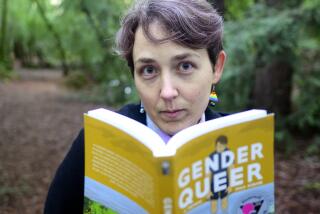What is biography? Who can be trusted? asks Jill Lepore in âJoe Gouldâs Teethâ
One winter, Jill Lepore, the prolific historian and New Yorker correspondent, taught a course called âWhat Is Biography?â To coax her Harvard sophomores to ponder whether we can truly know another person, she assigned Julian Barnesâ novel âThe Sense of an Ending.â She also gave them two famous New Yorker profiles by Joseph Mitchell: âthe delightful, Pickwickian 1942 story âProfessor Sea Gull,â and the much longer and much darker, Poe-like 1964 tale âJoe Gouldâs Secret.ââ
So far, spot on. And then Lepore, in her trademark forensic way, began fact-checking the life of Joe Gould. Originally, Mitchell depicted him as a mesmerizing Greenwich Village character, a brilliant, blue-blooded raconteur cadging booze and ketchup meals, ârestless and footloose as an alley cat.â Twenty-two years later, in a legendary, career-topping piece, Mitchell writes that he was duped.
It was a moving, gentlemanly confession and readers swooned. But âJoe Gouldâs Secretâ was also an elaborate defense of a pretty fable, one that Lepore calls âan act of deception.â
âJoe Gould was a toothless madman who slept in the street,â she reports in her frank and frankly unsettling new book, âJoe Gouldâs Teeth.â Her first four sentences each have a separate footnote â this is nimble detective work.
The pint-sized, disheveled Gould spent years writing âThe Oral History of Our Time,â an immense, ongoing record of his conversations and observations scribbled in dime-store composition notebooks, in ink stolen from post office inkwells. He wrote until his eyes gave out. In 1942, Mitchell estimated it ran some 9 million words.
âFor a time, [Gould] was rather remarkably well known,â Lepore writes. âChapters of his work appeared in avant-garde magazines nose to nose with essays by Virginia Woolf and drawings by Pablo Picasso. He went to parties with Langston Hughes. He dined with E.E. Cummings. He drank with John Dos Passos.â
Gould was catnip in this arty crowd, âthe writer who could not stop writing,â a pet bohemian who âstrutted along the streets of New York flapping like a seagull, âScree-eek! Scree-eek!ââ This signature behavior gave Gould his nickname and Mitchell a title, but it gives the contemporary reader a jolt that autism may have lain beneath street spectacle.
For the literati, Gould peddled a seductive notion: He was compiling the shirt-sleeved history of the common man. âI am trying to present lyrical episodes of everyday life,â he wrote. âI would like to widen the sphere of history as Walt Whitman did that of poetry.â
Strange Joe Gould â subject of E.E. Cummingsâ doggerel and a painting by Alice Neel (she gave him three penises) â once explained, âMy impulse to express life in terms of my own observation and reflection is so strong that I would continue to write if I were the sole survivor of the human race, and believed that my material would be seen by no other eyes than mine.â
Many may recognize this impulse. Occasionally it yields âLeaves of Grass.â Mostly, it yields drivel. But emphatically, it yields.
One permutation is the quantified-self, personal informatics movement â tools and apps that help people collect information about oneself for reflection and self-monitoring. Joe Gould stands, at a slant, at the headwaters of this firehose of self-regard.
Which brings us to his teeth. Most likely, he lost them in 1929 at the Manhattan State Hospital for the Insane, when patientsâ teeth were yanked routinely on the assumption that physical infection caused mental illness. Released back into the city at age 40, Gould was hired by editor Malcolm Cowley to write book reviews for the New Republic.
Still, Gould drank to excess and âbunked in flophouses and begged for handouts.â Seeking a dollar or a few coins, he asked his literary buddies, âAre you plunderable?â Gould himself had been plundered of his teeth, and the New Yorker plundered his story â or more accurately, a version of his story. Made famous by Mitchellâs âProfessor Sea Gull,â Gould wrote to the author, âI was only a figment of your imagination.â
Lepore is shrewd about the sticky ethics here, carefully documenting how little research Mitchell did, how much he preferred just listening to Gould. When Mitchell returned posthumously to his subject, matters became even murkier. âJoe Gouldâs Secretâ reveals that Gouldâs legendary masterwork, âThe Oral History of Our Timeâ was a chimera.
Here is how Lepore thinks of it now: âTwo writers guard an archive. One writes fiction; the other writes fact. To get past them, you have to figure out which is which. Joseph Mitchell said that Gould made things up. But Gould said that Mitchell did.â
Lepore ends her own book in a reverie, not a revelation, vexing our stubborn narrative expectation.
âIt made a better story in 1942 if the Oral History existed,â Lepore writes. âIt made a better story in 1964 if it did not.â She slips down the rabbit hole searching for it herself, and discovers what she thinks was Gouldâs actual secret: his racially tortured obsession with Augusta Savage, a Harlem Renaissance sculptor. Savage had rejected his marriage proposal, precipitating his first hospitalization. And quite terrifyingly, Gould stalked her; maybe worse. He had an ugly habit of groping women, abetted by powerful friends like Edmund Wilson, who served as a character witness in court.
Savage sculpted in Paris, returned to Harlem and, after the publication of âProfessor Sea Gull,â decamped for upstate New York. Almost nothing remains of her work and her life. Lepore speculates that she left the city to flee Gould.
âBut â and hereâs the trouble â from the moment I first learned about her, I knew that my likeliest error would be in thinking I understood Augusta Savage, as if she were me, when really, I hardly know her at all,â Lepore writes. This is one of her signature questions about the limits of biography.
And it is an eerie echo of Mitchellâs dilemma in appropriating Gould. âIt has taken me a very long time,â Lepore continues, âmy whole life, to learn that the asymmetry of the historical record isnât always a consequence of people being silenced against their will. Some people donât want to be remembered, or heard, or saved. They want to be left alone.â
Karen R. Long manages the Anisfield-Wolf Book Awards for the Cleveland Foundation.
::
âJoe Gouldâs Teethâ
Jill Lepore
Knopf: 256 pp., $25
More to Read
Sign up for our Book Club newsletter
Get the latest news, events and more from the Los Angeles Times Book Club, and help us get L.A. reading and talking.
You may occasionally receive promotional content from the Los Angeles Times.






